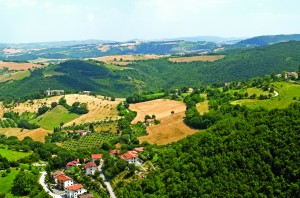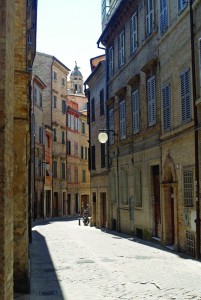Le Marche lies on the eastern side of Italy, east of Umbria, between majestic mountains and inviting sea.

The region is split into five provinces: Pesaro-Urbino, Ancona, Macerata, Ascoli Piceno and the recently constituted Fermo. Its proximity to both mountains and sea makes it very appealing to prospective homebuyers. The Adriatic coastline stretches some 180km and includes some of the best Italian Blue Flag beaches, while the steep eastern slopes of Italy’s mountainous backbone, the Apennines, includes the stunning Monti Sibillini in the south.
The main autostrada, the A14, and the state highway SS16 run swiftly along the coast, but further inland they are slower as they weave up and down the region’s hills between towns. The regular intercity train connections at Ancona link the region with Bologna and Rome. Ancona is also the site of Le Marche’s international airport at Falconara, which is served by Ryanair from London Stansted.
Le Marche boasts 13 protected areas, forests and nature reserves – including the majestic Monti Sibillini – and the National Park at Monte Conero on the coast near Ancona. Historically, Le Marche has a remarkable historical heritage too, with its medieval hilltop towns and villages and more than 30 significant archaeological sites and 200 Romanesque churches, as well as beautiful Renaissance city of Urbino.
Inland

Move inland from the coast and you will find the rolling hills and open fields of farming country, a peaceful landscape punctuated by pretty hilltop towns and gentle valleys. The quieter environment and slower pace of life make this is a popular area for British buyers. One of the region’s most eminent cities is Urbino. It rivals Florence for cultural significance and the more compact, bustling city has been designated a UNESCO World Heritage Site. Further south, the hill town of Macerata boasts one of Europe’s most outstanding outdoor theatres, the Arena Sferisterio, built in the 19th century to resemble an ancient Roman arena. The Stagione Lirica musical festival is held here every summer.

Close to the border with Abruzzo, the ancient town of Ascoli Piceno takes its name from the Picene tribe, who were conquered by the Romans in 89BC. The city was once a stop on the via salaria (the salt route) from Rome, but now enjoys a quieter existence. With one of the most beautiful marble-paved piazze in Italy, and a wealth of medieval architecture, there’s plenty to enjoy. Many other villages dot the landscape, including Arcevia (to west of Ancona) perched on the foothills and surrounded by historic castles; Offida in the south with its unusual triangular piazza and memorable Vin Santo; and medieval Jesi, near Ancona, with its castle, cobbled streets and famous Verdicchio wines.
Mountains

The Monti Sibillini National Park was created in 1993 when 700sqm of mountainous wilderness was set aside as a site of outstanding natural beauty. Rising to more than 2,000km high, this is a popular destination for naturalists, skiers in winter and walkers in the summer. The mountains form the border with Umbria to the west and the highest peak is Mount Vettore, at 2,476m.
The area is dotted with medieval towns and criss-crossed with walking trails. There is shelter at the network of rifugi (mountain huts) across the range and all the maps and guides you need to plan your routes can be found at the Casa del Parco visitor centres. Popular nearby towns include Amandola with stunning views of the mountains, and Force, famed for its artisans and wrought iron work.
Pushing aside the considerable charm of Le Marche’s old buildings for a moment, don’t forget that there are also plenty of nice, modern-built apartments along the region’s gorgeous sun-kissed coastline. Summer holiday rental returns are very good all across Le Marche, but they’re especially strong along the coast. A property here might make a good investment. Coastal areas also have the advantage of having been least affected by the recent earthquakes, of course. It is mountainous areas which bore the brunt of the damage, and which, alas, are said to be more at risk of seismic activity generally than areas nearer the sea.
And the future?
A burning question in many would-be buyers minds is simply “Will there be more of these serious earthquakes?” Unfortunately, it’s impossible to say. Italy’s tectonic set-up is extremely complex (the Italian landmass is technically a bit of Africa that crashed into Europe and is still pushing north into the Alps – which its impact created). Most of Italy has always been susceptible to earthquakes, although these are usually fairly minor. The recent spate of damaging, medium-sized quakes seem to be connected, according to seismologists, and they are thought to be the result of a stress which has been working its way northward through the Apennines. Whether that stress has now worked itself out or has more shaking to do further north is, unfortunately, anyone’s guess.

Choose a good location in Le Marche and a good property type, make sure your structure is earthquake-proofed to a high standard (this is a legal obligation anyway), and you should have little reason to worry. This is still an utterly enchanting and delightful corner of the world. And who knows? Maybe right now is the perfect time to buy your dream home here.
